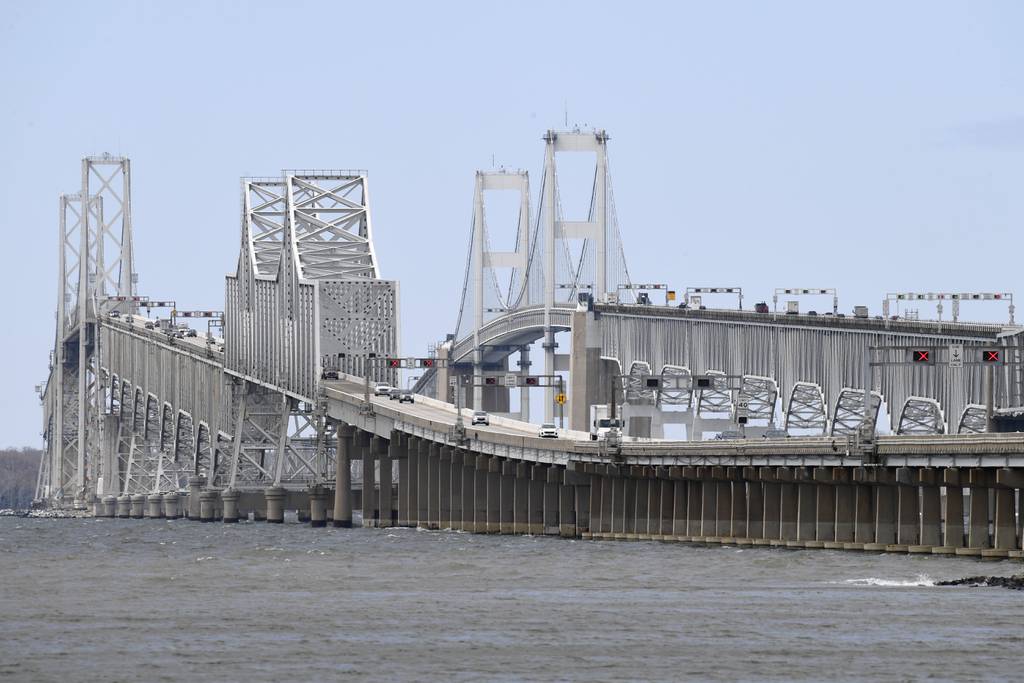
The William Preston Lane Jr. Memorial Bridge is seen from Stevensville on Kent Island. When the first span opened in 1952, the toll was $1.40. Today, the bridge over the Chesapeake Bay can be crossed for as little as $2.50 found trip. (AP Photo/Susan
The toll truth: No more free (or deeply discounted) rides | STAFF COMMENTARY
Originally published in the Baltimore Sun
The year was 1952 and gasoline sold for 27 cents a gallon, a new car cost less than $3,000 and postage for a first class letter was all of 3 cents. On July 30 of that year, then-Gov. Theodore McKeldin cut the ribbon officially opening the Chesapeake Bay Bridge. Thousands of people crowded Sandy Point to see the wonder of this two-lane, 4.3-mile-long engineering marvel, which would replace ferries connecting the Eastern Shore with the rest of Maryland. The toll charged on opening day: $1.40 one-way.
Today, gas costs about 14 times more, a new car averages about 16 times more, and first-class postage is 20 times higher. And where do things stand toll-wise at what is now known as the William Preston Lane Jr. Memorial Bridge (including its three-lane sister span added in 1973)? The cost for a standard two-axle vehicle is $2.50 roundtrip if you have an E-ZPass and live in Maryland, potentially less if you are a regular commuter.
That stunning, yet often forgotten, circumstance is worth keeping in mind as the Transportation Revenue and Infrastructure Needs Commission continues its deliberations over how best to finance Maryland’s transportation requirements in the future. Last week, the group discussed a toll increase — a prospect reinforced by Maryland Transportation Authority Executive Director Joseph Sagal’s observation that the MDTA hasn’t imposed one in more a decade. And one could hear the howls of reactionary protest float across the internet as if the state’s economy would soon be wrecked. “It will be even more expensive for working families across Maryland to get their kids to school, get to work, and go about their lives if the Maryland Transportation Authority gets its way,” moaned Christopher Summers of the Maryland Public Policy Institute, the right-wing “think tank.”
Not so fast, as they say about east-west commuting times in Baltimore. No driver much likes paying tolls, whether it’s done electronically or by flinging quarters at baskets. But then nobody much likes paying for cars, gasoline or postage stamps either, but we suck it up and move along. Why must time stand still at the state’s various toll roads, bridges and tunnels? Ah, because sometimes it’s politically expedient, which is why Maryland’s last governor twice lowered tolls. What’s the big deal if slashing tolls solidifies Larry Hogan’s legacy as a tax cutter even though it means the state doesn’t have the money (in its Transportation Trust Fund or elsewhere) to pay for future transportation projects — a third Chesapeake Bay crossing, for example? Oh, and nevermind that it was wildly inconsistent with the Republican administration’s position on public-private partnerships and the possibility of peak tolls of as much as $40 on a proposed $6 billion “Lexus Lane” widening of the Capitol Beltway and Interstate 270 (an expansion that may yet happen in some form but with more traditional government financing).
Here’s an idea: Maybe it’s time to act responsibly. Maryland needs to decide its transportation priorities and then how best to finance them. We’ve defended the state’s gas tax on these pages before, but we also have to acknowledge that in the era of electric vehicles and hybrids, the tax on motor fuels can only get you so far. As for tolls, they ought to be set with care. Had the Bay Bridge’s cost of passage kept up with inflation, the state could easily finance whatever bridge replacement was desired. But by keeping tolls artificially low, the state has contributed to longer commutes and environmentally questionable development patterns that have done some serious damage to the Chesapeake Bay.
Martin O’Malley took a thoughtful approach to transportation policy as governor — and it eventually cost him with voters. Hogan did not follow a sustainable path, and now Gov. Wes Moore has to clean up that mess by finding a way to put back on track neglected projects like Baltimore’s Red Line without a major tax increase (depending on one’s definition of “major”) or see traffic congestion worsen which is not only bad economic policy, it’s bad climate policy. Under such a circumstance, tolls that have barely budged for generations despite decades of sharply rising prices for everything else sure do look attractive as a possible target.
Baltimore Sun editorial writers offer opinions and analysis on news and issues relevant to readers. They operate separately from the newsroom.





